TRANSFORMING LINEAR FUNCTIONS
A family of functions is a set of functions whose graphs have basic characteristics in common. For example, all linear functions form a family because all of their graphs are the same basic shape.
A parent function is the most basic function in a family. For linear functions, the parent function is f(x) = x.
The graphs of all other linear functions are transformations of the graph of the parent function, f(x) = x. A transformation is a change in position or size of a figure.
There are three types of transformations —translations, rotations, and reflections.
Look at the four functions and their graphs below.
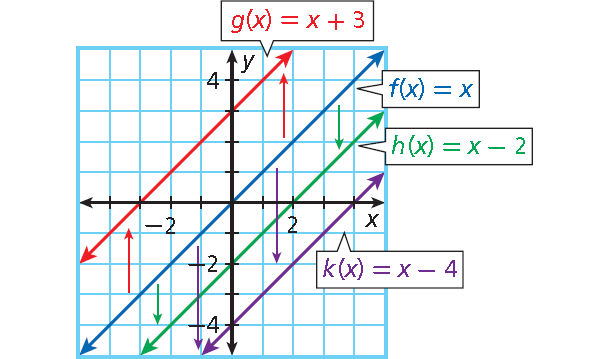
Notice that all of the lines above are parallel. The slopes are the same but the y-intercepts are different.
The graphs of g(x) = x + 3, h(x) = x - 2, and k(x) = x - 4 are vertical translations of the graph of the parent function, f(x) = x.
A translation is a type of transformation that moves every point the same distance in the same direction. You can think of a translation as a “slide.”
Vertical Translation of a Linear Function
When the y-intercept b is changed in the function f(x) = mx + b, the graph is translated vertically.
• If b increases, the graph is translated up.
• If b decreases, the graph is translated down.
Translating Linear Functions
Example 1 :
Graph f(x) = x and g(x) = x - 5. Then describe the transformation from the graph of f(x) to the graph of g(x).
Solution :
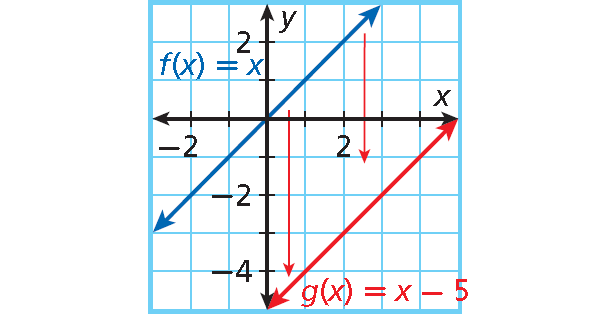
The graph of g(x) = x - 5 is the result of translating the graph of f(x) = x, 5 units down.
Rotation of a Linear Function
When the slope m is changed in the function f(x) = mx + b it causes a rotation of the graph about the point (0, b), which changes the line’s steepness.
The graphs of g(x) = 3x, h(x) = 5x, and k(x) = (1/2)x are rotations of the graph of f(x) = x. A rotation is a transformation about a point. You can think of a rotation as a “turn.” The y-intercepts are the same, but the slopes are different.
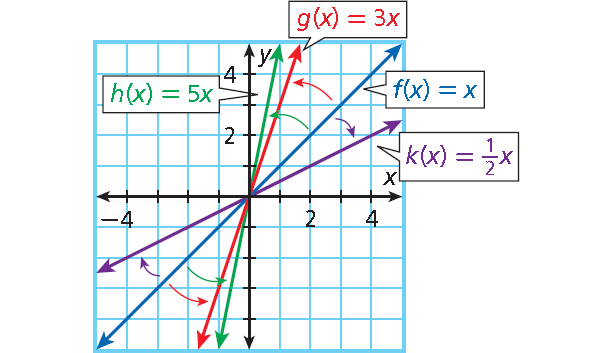
Rotating Linear Functions
Example 2 :
Graph f(x) = x + 2 and g(x) = 2x + 2. Then describe the transformation from the graph of f(x) to the graph of g (x) .
Solution :
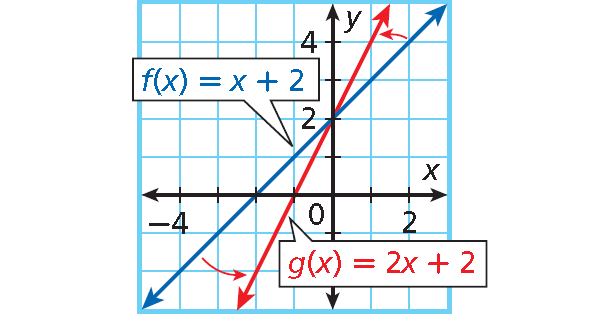
The graph of g(x) = 2x + 2 is the result of rotating the graph of f(x) = x + 2 about (0, 2). The graph of g(x) is steeper than the graph of f(x).
Reflection of a Linear Function
When the slope m is multiplied by -1 in f(x) = mx + b, the graph is reflected across the y-axis.
The diagram shows the reflection of the graph of f(x) = 2x across the y-axis, producing the graph of g(x) = -2x. A reflection is a transformation across a line that produces a mirror image. You can think of a reflection as a “flip” over a line.
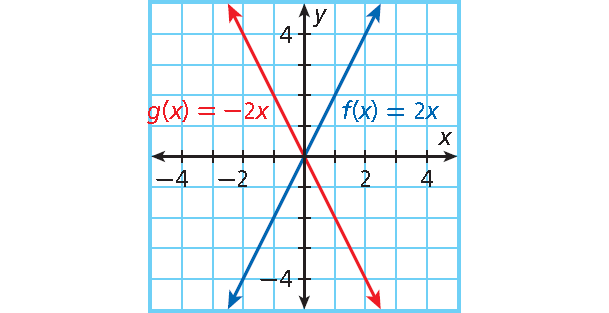
Reflecting Linear Functions
Graph f(x). Then reflect the graph of f(x) across the y-axis. Write a function g(x) to describe the new graph.
Example 3 :
f(x) = x
Solution :
To find g(x), multiply the value of m by -1.
In f(x) = x, m = 1.
1(-1) = -1 This is the value of m for g(x).
g(x) = -x
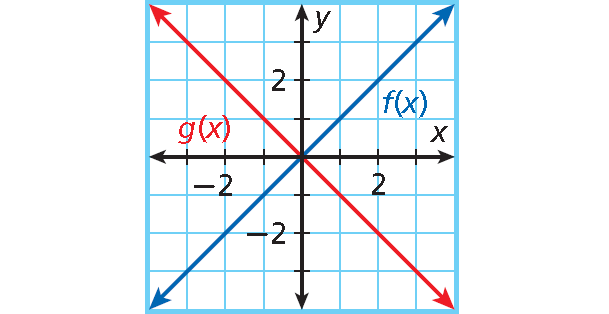
Example 4 :
f(x) = -4x - 1
Solution :
To find g(x), multiply the value of m by -1.
In f(x) = -4x - 1, m = -4.
-4(-1) = 4 This is the value of m for g(x).
g(x) = 4x - 1
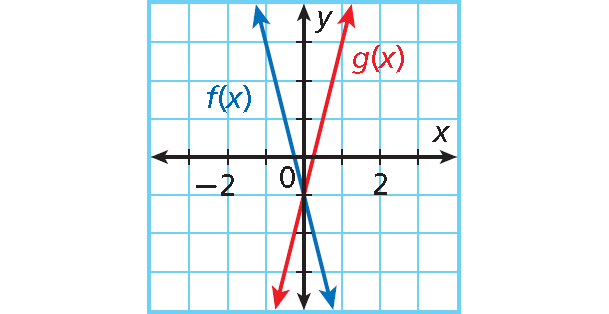
Multiple Transformations of Linear Functions
Example 5 :
Graph f(x) = x and g(x) = 3x + 1. Then describe the transformations from the graph of f(x) to the graph of g(x) .
Solution :
Find transformations of f(x) = x that will result in g(x) = 3x + 1 :
• Multiply f(x) by 3 to get h(x) = 3x. This rotates the graph about (0, 0) and makes it steeper.
• Then add 1 to h(x) to get g(x) = 3x + 1. This translates the graph 1 unit up.
The transformations are a rotation and a translation.
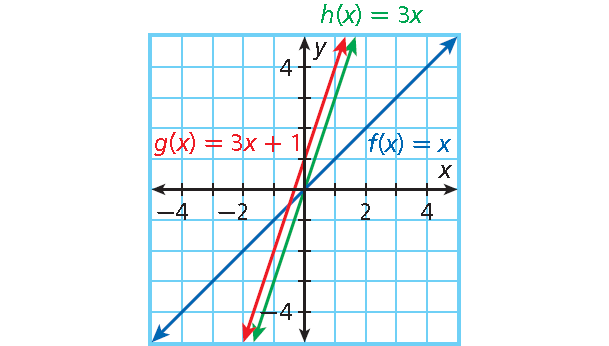
Business Application
Example 6 :
A trophy company charges $175 for a trophy plus $0.20 per letter for the engraving. The total charge for a trophy with x letters is given by the function f(x) = 0.20x + 175. How will the graph change if the trophy’s cost is lowered to $172? if the charge per letter is raised to $0.50?
Solution :
f(x) = 0.20x + 175 is graphed in blue.
If the trophy’s cost is lowered to $172, the new function is g(x) = 0.20x + 172. The original graph will be translated 3 units down.
If the charge per letter is raised to $0.50, the new function is h(x) = 0.50x + 175. The original graph will be rotated about (0, 175) and become steeper.
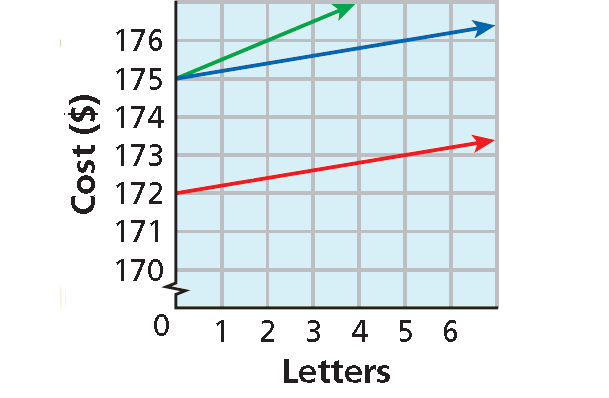
Kindly mail your feedback to v4formath@gmail.com
We always appreciate your feedback.
©All rights reserved. onlinemath4all.com
Recent Articles
-
Digital SAT Math Problems and Solutions (Part - 146)
Apr 18, 25 06:52 AM
Digital SAT Math Problems and Solutions (Part - 146) -
Logarithmic Derivative Problems and Solutions
Apr 16, 25 09:25 PM
Logarithmic Derivative Problems and Solutions -
Digital SAT Math Problems and Solutions (Part - 145)
Apr 16, 25 12:35 PM
Digital SAT Math Problems and Solutions (Part - 145)

